#Indian Tunic Man
Explore tagged Tumblr posts
Text
Outlander - Part 1

Pairing: Dean Winchester x OFC
Summary: Dean Winchester has been stripped of his military rank, but he’s living happier with his new wife, trying to adjust to a new life in her tribe. What will it take for her people to accept him, especially when the battle for her heart might not be completely won?
AN: Ready for some more Cowboy Dean? Here we go with Outlander Part 1! This is a sequel story directly following The Honorable Choice, where Dean not only saves the member of a Native American tribe, but falls in love with her. (She saves him a lot in return.) Now, he’ll have to learn how to live in her world if he wants to stay with her.
This sequel series will be 4 parts! 💜
Disclaimer: I first got inspired to write The Honorable Choice for @jacklesversebingo after a recent rewatch of Spirit: The Stallion of the Cimarron (with a tinge of Yellowstone in the mix). I’ve done a fair bit of research for this now ongoing series, both on the Native American Lakota tribe, and on American history during this time in the late 1800s; AKA: the Old West, during the American Indian Wars.
Jacklesverse Bingo24 Prompt: Western AU
Word Count: 5.3K
Tags/Warnings: 18+ only. Suggestiveness/implied smut and spice, hunting (in the more traditional sense), angst, hurt/comfort, and romantic fluff. **Pronunciation guide at the end!
🐎 Series Masterlist || Bingo Masterlist

Part 1: Two Worlds
Her people call this river Little Cheyenne. It’s because Big Cheyenne cuts through the land of the Sioux Indians by half, but Little Cheyenne almost meets it in the south, stretching all the way up to the Black Hills.
Mila’s tribe has always lived near this river. Its waters have bled red during battles with other tribes, and sometimes during battles with White Men.
The White Men’s fort, the one her husband came from, lies farther down in the south. The tribe had to move their village higher north along the river after Mila returned with Dean Winchester, just to be safe.
On a cloudy afternoon, Mila scrubs at a bundle of dirty clothes until they’re clean. She rinses them off in the river and is thorough about her work, but she knows she can’t be here much longer. She has a stew simmering on hot coals in her tipi…
Well, the one she now shares with her husband.
Unconsciously, she smiles. She remembers leading Dean through the tribe, to the place where she hoped he would find rest. They stopped at the foot of her tipi.
“This one’s yours?” he asked.
She paused, giving him another small smile.
“Ours.”
Mila continues scrubbing, though she frowns when her fingers slip through a tear in one of the new tunics she made for him (even though he keeps calling it a shirt). The tear was made by a blade, or maybe an arrowhead, she realizes.
The crunch of feet on the riverbed’s gravel makes her raise her head and look over her shoulder. Unease prickles down her spine. She braces herself for a familiar shadow, come to disturb her peace.
But then she relaxes. She’s being joined by two of the older women in her tribe. Mila has known them her whole life, and so she calls them tunwin. Aunt. They both greet her kindly and kneel beside her with their own bundles of clothes for washing, but Eyota, the older one, has a sharper eye. She is their tribe’s medicine woman.
“Your husband wears out his clothes,” she remarks.
“He’s been working hard training with Šóta and the other men,” Mila explains.
“He seems to be learning quickly,” says Misae. She has a more playful glint in her eyes. “Who knew that you could catch and tame a White Man. Looks like they are no different from wild horses.”
Mila smiles slightly, but it’s not genuine. She nods in agreement. “He’s learning quickly.”
She holds her tongue from saying anything else, even though she wants to. Dean isn’t a man to be tamed, any more than she was, in his people’s eyes. She aims to change the subject.
“Do you have any good herbs or spices for wahonpi? I’ve had the stew simmering all morning,” she asks Eyota. Not only is she a gifted healer, but Eyota is also one of the best cooks, and she knows it. She nods and straightens her shoulders the way she always does when someone asks her for advice—and even when they don’t ask for it.
“Of course, child. What you need is…”

“Goddamn it,” Dean huffs under his breath.
The jackrabbit flees from him again, or more accurately, from his terribly aimed arrow. He’s an excellent marksman…just not with a bow, it seems.
He doesn’t know what he’s doing wrong here, and he’s not likely to figure it out. Not by the way Takoda, Šóta, and the other men are laughing at him.
Dean resists the urge to roll his eyes. He knows when he’s being hazed.
These men are bare-chested warriors, each of them richly tanned under the sun. Most of them wear their hair long, half of it gathered high on their heads, or braided in some way. Šóta is his wife’s cousin, and as the Chief’s son, he wears a small adornment of eagle feathers threaded into his hair. His closest friends are Takoda and Otaktay. Both of them laugh at Dean the most, and in their language, using just enough gestures and body language that Dean knows he’s being talked about. They point at his boots and his brown Stetson hat—two of the only things he’s kept of his own that make him feel comfortable in his own skin.
Finally, Šóta goes over to him. “Good try,” he says, in his usual patronizing tone.
Dean knows he can’t punch out Mila’s cousin, no matter how bad he’s asking for it. Somehow, Dean manages to hold onto his temper.
“What’re they saying?” he asks lowly, gesturing at the two chuckle brothers.
Šóta’s lips twitch. He glances down at Dean’s feet. “They say your…shoes are loud on the earth. You give yourself away before the animal even catches your scent.”
Dean’s given up a lot of things, but his boots won’t be one of them. He wants to learn. He wants to belong here, in Mila’s world, but he also wants to stay himself.
So the men move on, mounting their horses. Dean rides with Baby at a plodding clip. Her black coat ripples with a healthy sheen. He thinks she’s come to enjoy the more natural surroundings and freer pasture of the grasslands, and he can’t deny, this part of it all feels right. The sun peeks through between the dappled leaves of oak trees, painting the ground in red, green, and gold. It’s quiet and beautiful here as Šóta leads the pack through the forest, just southwest of the village.
Eventually, he stops them between a denser thatch of trees and shrub. He raises a hand signal that Dean’s come to recognize. He raises his bow belatedly after the others though. He follows Šóta’s line of vision, and there is a deer grazing in a small clearing. A young buck.
Šóta signals at Dean. Try again, his eyes say.
Dean takes in a deep, quiet breath through his nose, and he takes aim.
He really misses his damn rifle.

Dean shoulders the sting of failure while he makes his way through the camp, leading Baby by the reigns. He drops her off at the large horse pen. There he feeds her and brushes her long coat, all while murmuring soft affectionate things. She’s still one of his only friends here.
But even she leaves him short to join her new friend, Mato. The two have become thick as thieves. Mato greets the black mare with a friendly whinny. Their noses touch in affection, and Mato playfully nips at her ear.
Dean raises his brows. “Well, that’s a little more friendly than usual. You guys start courting when I wasn’t looking?”
He walks over to Mato, who’s softened up to him in recent weeks.
“You sly dog,” Dean remarks, smirking. “Didn’t even ask me for her hand.”
Mato blows a hot breath through his nose at Dean, who has to blink, wiping his face.
“Now that’s just rude.” Still, he offers the mustang an apple from his pocket. Mato takes it from his palm, letting Dean rub his neck while he munches on his snack. “As fathers-in-law go, you lucked out, pal. See? I’m a delight.”
He wouldn’t be surprised if Baby had her first foal by spring. Dean grins at the thought, but it soon falls. If only his father-in-law were so easy to please.
His mind dwells on it as he starts making his way back to the heart of the village. Chatan, Mila’s father, hasn’t warmed up to him any better than Šóta or the other men. Tahatan is the only one of them who treats Dean civilly, and overall, he seems to be a good leader.
Dean has that thought, just when he sees the older man himself walking with a woman Dean sort of recognizes. She wears a long necklace made of blue beads and seashells. Tahatan goes into her tipi, even though Dean knows…that woman isn’t the Chief’s wife.
Dean raises his brows, but he subtly pivots on his heel and takes a different route back to his own tipi. Whatever he just saw, it’s definitely not his business.

“Honey, I’m home,” he teases.
She welcomes him into her arms, her hands traveling warmly up his shoulders. He bends to kiss her, soft and slow at first. And then deeper, sucking on her lower lip and teasing her with a sensuous tongue. She hums in surprise into his mouth, making him smile.
He’s exhausted and feeling low, but he doesn’t want to let on to her. He just wants to forget about his day, and hopefully recharge with a better night.
“How did it go today?” she asks, after he allows her to breathe.
Dean nods (and lies). “Pretty good.”
She waits for him to continue. When he just continues to hold her, she raises her brows up at him.
“Dean?”
“What? I’m workin’ on archery. Lots of progress.”
She eyes him in suspicion, and he knows he doesn’t have her fooled. Actually, she looks like she’s going to press him about it, so he releases her from his hold and goes to change out of his dirty clothes to avoid her gaze.
“Hey, uh, maybe it’s none of my business, but I saw the Chief go into some other woman’s tent today. Holding hands, bedroom eyes, the whole deal,” he says while he changes. He glances back at her and waggles his brows. Mila smiles slightly.
“Did she wear her hair in a half-braid, or did she wear a necklace made of seashells?” she asks.
Dean’s surprised that she doesn’t seem surprised, but he thinks back to what he saw.
“Uh, seashells. Yeah, she wore seashells,” he says.
Mila nods. “Yes, that woman is also his…the chiefs of my people are known to take more than one wife.”
At that, Dean becomes even more surprised. He finishes dressing and leaves his boots by the tipi’s entrance. His raised brows even out into a smirk.
“Well, okay. Guess it’s good to be Chief,” he says.
Mila’s lips purse as she eyes him narrowly. She goes back to stirring the stew with a wide, wooden spoon. Dean doesn’t see her reaction, but he does notices that something’s missing from his side of the bedding. He frowns.
“Hey, where’s my gun?” He asks Mila, who shakes her head without looking at him.
“I moved it,” she curtly replies.
Dean’s frown deepens. He touches her arm to get her attention.
“I’d rather you didn’t do that, baby,” he says. He’s made sure that she knows the basics of a gun well enough, but he doesn’t want to take the chance of her hurting herself.
“Don’t leave it out, then,” she snips back. “It shouldn’t go where we sleep.”
Dean tilts his head at her. He’s a bit confused at her tone, especially because they’ve had this conversation before.
“I have it there just in case something happens at night,” he reminds her. His pistol is really just for emergencies though. There are only three bullets left in it, and he can’t exactly go shopping for more.
Dean realizes then that Mila’s mood has shifted. He approaches her from behind.
“What’s wrong, huh?” His hands find familiar purchase along the curve of her waist. He swipes her braid away and presses a kiss where her neck meets her shoulder. More teasingly, he asks, “What’d I do now?”
Mila remains tight-lipped, until she glances at him over her shoulder.
“Do you want another woman?” she asks.
It’s a simple question, but it succeeds in completely tripping him up. He blinks at her, incredulous and bewildered.
“What?”
She continues shredding another herb to put into the stew. Somehow, it makes the broth smell a bit worse.
“You seem to admire the Chief for having three wives, so you must want another one too,” she says.
Holy shit, three wives? Dean wonders. The man must be a saint. Look at the hell I’m catching with one.
He can’t help but laugh, a deep belly chuckle that does nothing to take away Mila’s ire. She glares at him now, genuinely upset, and Dean knows he’s starting to shit the bed on this one. He sobers up and raises his hands in surrender.
“Sweetheart,” he says, in a placating tone.
Despite her annoyance, she allows him to hold her again. He plies her with more tantalizing kisses along her neck. He breathes in the sweet-smelling oil she uses on her hair.
“You’re more than enough woman for me. You know that, right?” he whispers against her skin. It earns her slight shudder, and he smiles. He teases the spot just under her ear, grazing with his teeth, then soothing with his tongue. She can’t help but writhe against him a bit. It stirs a well of desire in his lower belly, especially when he squeezes her hips, pressing himself to her from behind.
She tries to remain strong as she clears her throat, no doubt feeling his growing hardness against her. She starts to blush hotly.
“It’s all I can do just to make sure you stay sweet for me,” Dean says, a hint of teasing returned to his voice.
Mila finally breaks into a laugh. She reaches back to swat him on the head, but his ministrations work. Once she manages to escape from his grasp with a teasing smile of her own, she more happily serves him a bowl of stew.
Dean smirks. Fine, he can be patient. He’ll just have to wait until dessert, then. After a moment to calm himself, he sits down on the ground beside her and brings a large spoonful of stew to his lips. There, he pauses. The strange taste that assaults his tongue nearly makes him choke, but he does his best to swallow it down. The meat’s tough as nails, for Christ’s sake…
Hearing a spoon clatter against the bowl, he chances glancing at Mila. She sits stock still, her brows furrowed as she frowns. Slowly, she sets the bowl down and says,
“Stop eating.”
She looks angry at herself. Dean feels bad for her, his sympathy striking at his chest.
“What do you mean? I’m hungry,” he says, and gamely takes another couple of bites.
She just watches him. Her upset worsens while he tries and fails to cover up a hacking cough.
Finally, Mila can stand no more. She takes the bowl from him, making some of the foul broth slosh over their hands and onto the ground. She tried to make wahonpi, one of the most basic soups in her people’s culture, made from bison, potatoes, corn, and carrots stewed in the broth.
Eyota told me it was simple! she thinks in dismay. How did it go so wrong?
“It’s no good,” she says, her voice hard. “I will go to my mother and see what she cooked. She may have extra for us.”
She rises to her feet, and Dean quickly follows her. He catches sight of her tears, even though she turns her face away from him to grab her shoes. He reaches out and stops her with a hand on her arm. He tugs her back to face him.
“Hey, it’s okay. Why’re you getting so upset?” he says. “I’m not picky. I’ll eat whatever you make.”
Or maybe next time, I’ll try doing the cooking, he thinks.
“Because!” she blurts. Tears well up in her eyes and begin to slip down her cheeks, no matter how much she tries to brush them away. “Because you shouldn’t have to eat it. Because it should be good. You deserve to eat something good!”
Mila finally realizes why her mother tried so hard to teach her these things. She’s embarrassed, feeling sorry for herself, but it’s also far worse than that. Her heart hurts knowing what Dean has gone through, and what he continues to go through for her sake. The least she could do is make sure he eats well, and it seems she can’t even do that.
“Mila,” he says with a sigh. He guides her into his embrace. “It’s okay, sweetheart.”
She can’t allow herself to be comforted. She pushes at his chest to look up at him.
“You think I don’t know what happens outside?” she says. “It’s a small village, and people talk when they think I’m not listening. I know what the men are doing to you.”
Dean shakes his head stubbornly. “It’s fine. I can handle it.”
“You should not have to,” she insists, resting a hand over his heart. “You have proven yourself to be a man of honor. Tahatan said it himself. They should not be this way.”
Dean smiles ruefully. “I can handle it.”
He bows his head and captures her lips, plying her with a deeper kiss. The heat of it grows and becomes more than a distraction, more than comfort. It strips everything else away, until it’s just the two of them again, like the night she found him at the riverbank and held him until he woke up in her arms.
What they eat doesn’t matter. Other people don’t matter. All that matters is this.
He squeezes her hips and presses her harder against him, so she can feel every part of his desire. She moans into his mouth, curling her fingers into his shirt. So he guides her down to the bedding, where he shows her what he’d rather get a taste of.

Later that evening, Mila and Dean have dinner with her parents. Her mother, Weaya, is a gracious host, treating Dean both like a guest and a proper son-in-law. She gives him a special cut of braised bison meat, not to mention extra corn and potato hash. Chatan says nothing to him and eats in gruff, stoic silence.
Dean can tell it both hurts and annoys his wife, but he has to focus on answering Weaya’s many questions about his life—mainly about his family and the farm he grew up on. In some ways, raising crops and rearing up cows, chickens, and horses there isn’t so different from the Lakota village.
“You must miss that place. Your home,” she says. Dean meets his mother-in-law’s eyes, pausing in polishing off the meat sauce on his plate with a piece of bread. Chatan looks up from his meal, and so does Mila, who hesitates too. He sees the thread of her concern there, behind her eyes, so Dean hides the stab of sadness that hits him every time he thinks of Lawrence.
“Sometimes,” he admits. He looks over at Mila. “But I’m not alone. That’s what matters.”
She smiles at him softly. Dean has the urge to take her hand, maybe raise it up to his lips, but he’ll leave that for when they’re alone. He doesn’t want to upset her father any more than he has just by sitting in Chatan’s house. Tent…whatever.
He’s glad when, after almost another hour and a round of hot tea, Mila finishes chatting with her mother and stands. It means they can finally get the hell out of here. No disrespect to her parents, but with so much change happening so quickly, Dean had been able to put Lawrence out of his mind for a while. Tonight he thinks about his mom and his brother more than makes him comfortable on their way through the village. He follows Mila inside their tipi, then starts up a candle while she gets ready to rest for the evening.
Living here is like going back in time—before the lantern, before indoor plumbing and the water heater. It’s not a huge hardship for Dean, who’s spent a lot of his life sleeping on hard, dusty ground, or military bases with less than most modern amenities, but it’s still another adjustment.
He undresses down to his pants and settles down to the bedding and furs, waiting for his wife. She kneels beside him after undressing down to just her shift. He lays on his back with an arm tucked behind his head, and he watches her unbind her long, dark hair, undoing the braid from the bottom strands. She has this concentrated look on her face, like her mind is far away, even though she’s right here next to him. He threads his fingers through her loose hair while she works, giving her a smile.
“You okay?” he asks.
Mila pauses. She lets her tresses escape from her fingers and reaches for him, laying her hand on his chest. Dean holds it there and finally allows himself to press a kiss into her palm.
I’m sorry, is what she wants to say, but she knows he’ll only reply, For what?
So she lowers down and slips into his warm embrace, as if this can make them both forget the day. She rests her cheek over his beating heart.
“You will never be alone,” she promises.
Dean quirks a smile. Instead of answering, he brushes her cheek tenderly with his hand, and he closes his eyes. A few deep breaths later, and he finds sleep.
The candle slowly flickers out.

On most nights, Mila falls asleep before Dean, and so his light snores don’t bother her. Tonight, even though she’s tried, she can’t tune out his rumbles. Or maybe it’s her own mind she can’t tune out.
She carefully maneuvers out of his hold and slips on her shoes. Maybe the moon will give her clarity tonight.
She pushes open the front flap of the tent and steps out into the cooler air. She looks up at the moon’s white-blue glow, a wide crescent peeking out from between two large clouds. A strong breeze tugs at her hair and flutters her lashes when she closes her eyes. She crosses her arms when goosebumps spread across her tan skin.
“What troubles you, Kimmímila?”
The voice is steady and male, and all too familiar. Still, the intrusion startles her. Her eyes fly open wide and she jolts, inhaling sharply. She frowns when she realizes it’s him.
“What are you doing? It’s late,” she says.
He steps out from the shadows with his pipe in hand. He smells strongly of tobacco. Her father and uncle smoke as well, but she doesn’t like it herself. She’s glad Dean doesn’t either.
“Easing my mind,” he says, raising his pipe. “I see you’re up to the same thing.”
Mila shakes her head. She returns her attention to the moon. “Go. You shouldn’t be here.”
“Are we not friends, Mila?” he says. “Can’t we talk and share like we used to?”
His voice is disheartened enough that it earns her gaze. She sighs at him.
“I am sorry, but I can’t give you what you want,” she says. “Don’t test me anymore.”
He pauses with his pipe in hand. It drops to his side, and he takes measured steps closer, until he’s looking down at her. Even with the litheness of his form, he’s still taller and broader than her. His long, dark hair is half pulled onto the top of his head, threaded together with a beaded leather string she made for him when they were children. He has used it ever since. The rest of his hair lays loose down his back, brushing his arms.
“If you actually loved him, it wouldn’t be a test,” he teases.
He tries to touch her cheek, but she guides his hand down. She shakes her head and steps away from him.
“This isn’t a game,” she says. “You know I mean what I say.”
His anger and frustration surfaces, with a sharp exhale of breath and the crunch of his dark brows.
“You would choose the Outlander over your own people,” he accuses.
Mila’s gaze is firm as she heads back to her tipi. If he will not be reasonable, then she will make it clear enough to hurt.
“I choose him over you,” she says.
Then, she slips back inside.
The shadow outside remains, just long enough for the moon to become clear past the moving clouds.

In the morning, Mila goes to her uncle, Chief Tahatan. She finds her parents there in his tipi as well, all of them sharing breakfast. Her aunt passes around more bread and wojapi, a sweet mixed berry sauce, while her father is resting a broken ankle. He’s complaining again, even though it happened over a week ago now.
“If you hadn’t let the horse buck you off, you wouldn’t be hurting,” she says sharply now. She’s become annoyed with his griping. “Or better yet, you can finally admit that you’re beyond the years of breaking young stallions.”
Chatan is the Horsemaster of their tribe, and has been since Mila was a little girl, inheriting the position from her great uncle, the former chief’s younger brother. Mila knows, however, that Chatan is getting too old to do the harder work. Many years have meant many battles too, and they’ve taken their toll on his bones.
An idea grows in her mind, and she goes to sit beside her father. She applies the poultice Eyota gives Weaya for him, before rewrapping his ankle.
“Father,” she begins, imploring him gently, “perhaps Dean could help you care for the horses.”
Chatan eyes her with a frown. “Your husband already has his hands filled with training.”
“Šóta and Takoda can’t do it all themselves, and Dean has experience with breaking young horses,” she reasons.
Chatan ignores her and hefts himself to his feet without her or his wife’s help. He leaves with her mother on his heels, even though she looks back at her daughter apologetically. You know your father, her eyes say.
Mila frowns at his back, both frustrated and upset. When they’re gone, she heaves a sigh. She remains determined though.
She goes to Chief Tahatan next. He sits in his chair of whicker and wood while he smokes his pipe. Her aunt has gone to help the other women harvesting chokeberries and wild onions. Mila will go there soon, but first, she has business here.
“Uncle,” she says.
He makes a sound of acknowledgement, crossed between a grunt and a groan. He knows what's coming. She kneels at his feet and touches his hand in a sign of humbleness, reverence, and familial love all at once.
“Uncle,” she repeats. “Dean has done nothing but try to please Father, but still, he’s being stubborn…will you talk to him? Please?”
Tahatan sighs deeply. “You must understand your father, child. The decision you’ve made affects us all.”
“I do understand, Uncle. But the truth of it is, none of you have given Dean a chance to prove himself.”
“His chance is right now,” Tahatan says, his tone more stern. “Have I not been gracious? Did I not allow him to stay and live among us?”
“Yes, but you continue to judge him in your mind, like everyone else,” she says. The Chief remains quiet. She moves to stand before him, holding his gaze directly. “Let us perform the Huŋkápi.”
Huŋkápi. The Making of Relatives. Her people first created the tradition to make peace between Lakota and rival tribes, like the Ree. It can even be used to unite extended families within the tribe, especially in times of marriage. There is no better time for it, she thinks.
The Chief shakes his head. “Kimmímila.”
“Is he not my husband?” she says. “In the eyes of our people, this is the joining of two families, and accepting an outsider into our tribe. That is exactly what the ceremony is for.”
“He has no family,” Tahatan snaps. “It is not exactly the tradition.”
“Then let us make it new,” she argues.
Tahatan hesitates. He shakes his head and rubs at his chin in a gesture of long-suffering. He thanks the spirits that he never had daughters. While he loves his niece, he has never envied his brother.
“I will think on it,” he says.
Mila frowns, but she tries her best to accept this, for now. She thanks him respectfully and leans in to kiss his cheek. Tahatan grunts an acknowledgement and watches her go with another shake of his head, despite a small smile. Between her and his sons, they will keep adding years to his life.

On her way out of the Chief’s tipi, she runs into her cousin, Šóta. He walks with all the comfortable cockiness of a rooster among his harem.
“Good morning, sister,” he greets, even as he playfully pulls at her braid and tosses it into her face.
She flicks it away and meets him with an irritated frown. She’s in no mood to be teased, especially by him. “You’re still a child.”
“Ho-ho, hey now,” he chuckles, and he cuts off her path by standing in her way, crossing his arms. “Watch it. When I become Chief, don’t think I’ll let you talk to me so disrespectfully, my sister.”
“Just because you will be Chief one day does not make you wise,” she says. Her voice is as sharp as the snap of a blackberry vine. “And don’t call me sister. You have lost that right.”
Šóta finally becomes serious; he realizes that she means what she says.
“What are you talking about? What have I done?” he asks, more earnestly.
“It’s what you haven’t done,” Mila snaps. “If you were a good leader, you would take your father’s words to heart when he accepted my husband into our tribe. If you were my brother, you wouldn’t let the men mock him. If you were a man at all, you would do what is right. You would be guiding him right now, instead of letting the others ‘train’ him.”
She storms away from him, leaving Šóta feeling irritated, but also with an uncomfortable feeling beginning to churn in his gut.
Mila moves brusquely through the camp until she reaches the clearing edged by the forest. There the horses are fenced in. They’ve been given their food and water for the morning, so they’re rather frisky as they clop around and graze.
She looks for Mato. Baby is no doubt with Dean today, so the Kiger mustang keeps to himself underneath a large sycamore tree. His tail flicks when she approaches, and he turns to her with a sound of greeting. She allows her hand to run along his dun-colored coat as she draws closer.
“I need you, my friend,” she whispers.
She holds his snout, pressing her forehead against his as she squeezes her eyes shut against the burn of frustrated tears. Mato bumps her shoulder with his nose, softly whinnying. She smiles, sniffling, and rubs his cheek.
“Let’s go for a ride.”

AN: Well, here we go! Sorry for ending on some angst, but here we've got the pieces in motion for a fun-filled, four-part sequel. 😂💜 Dean and Mila are both struggling in their own ways while he tries to navigate this new world he's trying to live in.
And how do you think he's gonna react to the "mystery man" trying to win her back? 😬
Pronunciation Guide:
Šóta ("sho-tah") Chatan ("chat-tan") Tahatan ("ta-hat-tann") Otaktay ("ogh-tac-tay") Weaya ("we-ayy-ya") Takoda ("ta-koda") Mato ("matt-toe") Misae ("mee-sah-eh")
Next Time:
But she feels a shadow at her feet as she ventures through the village. They are getting bigger as a tribe, harder to move when they need to, and it’s more mouths to feed, but it’s also a good thing. Despite all the challenges the past few decades have brought, their people are enduring.
However, she pushes these thoughts to the back of her mind when she feels a prickling down the back of her neck. It’s followed shortly by the strong hand that closes on her wrist, and the man that calls her name.
She gasps and whips around. He is there, gently shushing her. She glares at him and tries to pull her hand out of his grip.
▶️ Keep Reading: PART 2


Join My Patreon 🌟 Get early access to new stories, bonus content, and first looks at upcoming stories, send me requests, and more!
Outlander Masterlist
The Honorable Choice Masterlist
Jacklesverse Bingo Masterlist
Dean Winchester Series List
Dean Winchester Masterlist
Main Masterlist

Series Tag List (Part 1)
(Going back to the regular Dean tag list, plus those who said they'd like to be tagged on this series!)
@hobby27 @kazsrm67 @jacklesbrainworms @foxyjwls007 @mostlymarvelgirl
@thebiggerbear @roseblue373 @this-is-me19 @emily-winchester @deans-spinster-witch
@deans-baby-momma @sanscas @kaleldobrev @spnwoman @samanddeaninatrenchcoat
@globetrotter28 @adoringanakin @midnightmadwoman @chevroletdean @iprobablyshipit91
@chriszgirl92 @lyarr24 @ladysparkles78 @spnfamily-j2 @pieandmonsters
@deansbbyx @sarahgracej @chernayawidow @mimaria420 @stoneyggirl2
@fics-pics-andotherthings-i-like @waywardxwords @waynes-multiverse @twinkleinadiamondsky @mxltifxnd0m
@my-stories-vault @kayleighwinchester @rizlowwritessortof @samslvrgirl @tortureddarkstar
@tmb510 @syrma-sensei @artemys-ackles @malindacath @mrsjenniferwinchester
@jc-winchester @charmed-asylum @fromcaintodean @k-slla

#Two Worlds#Outlander#Part 1#Jacklesversebingo24#The Honorable Choice#dean winchester#dean winchester angst#dean winchester x oc#supernatural#spn#dean winchester fanfiction#dean x oc#dean winchester imagine#dean winchester smut#dean winchester fanfic#supernatural fanfiction#spn fanfic#jensen ackles#jensen ackles x oc#jensen ackles fanfiction#jackles#dean winchester au#western au#dean au#dean winchester x original character#sam and dean#dean winchester x ofc#benny lafitte#sam winchester#zepskies writes
107 notes
·
View notes
Text




Steed Acquisition
[Image ID:
Four sequential digital paintings of Sir Gawain acquiring Gringolet the horse
The first is of Gawain, an Indian man with heterochromia in red and white checkered hose and sleeves with a green tunic and holly-embroidered hood, sat astride Gringolet, a dapple grey Highland Pony with red tack. He bears a red kite shield with a gold pentacle, a motif also seen in the tack. The text reads, in an old English font, Sir Gawain’s FAILSAFE GUIDE to acquiring a NOBLE STEED.
The second is a silhouette of an armoured man on horseback chasing down Gawain on foot against a tumultuous sky. Gawain’s arms are cartoonishly placed. The text reads: Step One: Stop Running.
The third is a red-washed scene of Gawain splitting the other knight’s helmet open with a sword, with comically exaggerated motion like an old cartoon hammer strike. The text reads: Step Two: Unspeakable Violence. The text appears spattered with blood.
The fourth is a bust of Gawain kissing Gringolet on the cheek, hand affectionately wrapped around the horse’s nose. They are surrounded by the outline of a heart and the text reads Step Three: Profit.
End ID.]
#cattle rustling for fun and profit#arthuriana#gawain#sir gawain#gringolet#my art#the lancelot grail#Gringolet is my best beloved#also full disclosure I listened sequentially to High Noon over Camelot and then the Green Knight soundtrack
99 notes
·
View notes
Text

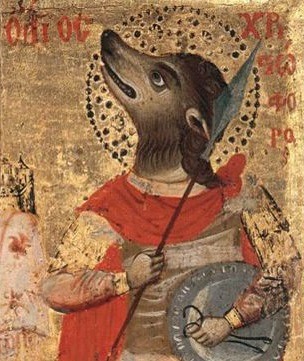



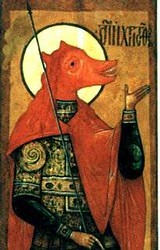

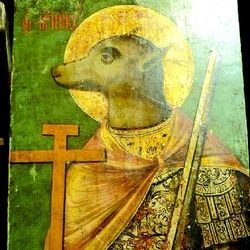

St. Christopher, The Christbearer
Dog-man, Cynocephali Saint, christened by baby Jesus after helping him cross a river.

The Dogheaded people
They were seen by conquerors, explorers, evangelists and described in detail. Alexander the Great, Marco Polo, St. Augustine, Christopher Columbus all described these creatures. You also have Anubis the Egyptian god and St.Christopher who was converted to Catholicism and achieved Saint-hood by helping believers cross a river.
There were letters corresponding with the Vatican on whether or not these dog headed men could be saved or not. The Catholic church was not surprised and simply asked if their eyes were on the front of their heads or on the sides. Apparently dog headed men were nothing new to cultures around the world.
'Ratramnus’s Epistola de Cynocephalis, is a letter written concerning if dog headed men could be saved. The response was yes based on the evidence that they showed the ability to have free will; they wore clothes, kept animals, had relationships, and obeyed laws etc. So they could choose salvation and therefore could be worth ministering to.
( Canaanites = canines, described as cannibals and great fighters who did detestable things.)
In Tibet there was recorded history of over 200,000 living in a village. They lived in Parts of India along the Mountain Range, there are traces of them in the Celtic lands they lived in Ireland.
St. Christopher is the patron saint for travelers. Dog-headed people often have acted as guides, ferries and Shepards. I will cover this in a future post, which will feature Xolotl and Aztec Gods, including Anubis!
Canines are interwoven into human history.
On these mountains there live men with the head of a dog, whose clothing is the skin of wild beasts. They speak no language, but bark like dogs, and in this manner make themselves understood by each other. Their teeth are larger than those of dogs, their nails like those of these animals, but longer and rounder. They inhabit the mountains as far as the river Indus. Their complexion is swarthy. They are extremely just, like the rest of the Indians with whom they associate. They understand the Indian language but are unable to converse, only barking or making signs with their hands and fingers by way of reply, like the deaf and dumb. They are called by the Indians Calystrii, in Greek Cynocephali (“dog-headed “). [They live on raw meat.] They number about 120,000. Near the sources of this river1 grows a purple flower, from which is obtained a purple dye, as good in quality as the Greek and of an even more brilliant hue. In the same district there is an animal about the size of a beetle, red as cinnabar, with very long feet, and a body as soft as that of a worm. It breeds on the trees which produce amber, eats their fruit and kills them, as the woodlouse destroys the vines in Greece. The Indians crush these insects and use them for dyeing their robes and tunics and anything else they wish. The Cynocephali living on the mountains do not practice any trade but live by hunting. When they have killed an animal they roast it in the sun. They also rear numbers of sheep, goats, and asses, drinking the milk of the sheep and whey made from it. They eat the fruit of the Siptakhora, whence amber is procured, since it is sweet. They also dry it and keep it in baskets, as the Greeks keep their dried grapes. They make rafts which they load with this fruit together with well-cleaned purple flowers and 260 talents of amber, with the same quantity of the purple dye, and 1000 additional talents of amber, which they send annually to the king of India. They exchange the rest for bread, flour, and cotton stuffs with the Indians, from whom they also buy swords for hunting wild beasts, bows, and arrows, being very skillful in drawing the bow and hurling the spear. They cannot be defeated in war, since they inhabit lofty and inaccessible mountains. Every five years the king sends them a present of 300,000 bows, as many spears, 120,000 shields, and 50,000 swords. They do not live in houses, but in caves. They set out for the chase with bows and spears, and as they are very swift of foot, they pursue and soon overtake their quarry. The women have a bath once a month; the men do not have a bath at all, but only wash their hands. They anoint themselves three times a month with oil made from milk and wipe themselves with skins. The clothes of men and women alike are not skins with the hair on, but skins tanned and very fine. The richest wear linen clothes, but they are few in number. They have no beds, but sleep on leaves or grass. He who possesses the greatest number of sheep is considered the richest, and so in regard to their other possessions. All, both men and women, have tails above their hips, like dogs, but longer and more hairy. They are just, and live longer than any other men, 170, sometimes 200 years (Ctesias, “Indica”, from Photius I).



26 notes
·
View notes
Text

Unidentified Dakota man
Credit : Denver Public Library Special Collections
Creator : Walter Sherburne Photographic Art Gallery.
Date : 1870
Standing portrait of an unidentified Native American Dakota Sioux man wearing a tunic, leggings, long kilt, hair pipe breastplate, and parted long loose hair.
Dakota Indians--Clothing and dress; Indians of North America
5 notes
·
View notes
Text
Unveiling the Splendor of Ancient Indian Clothing and Style
India's rich history is adorned with a tapestry of clothing and fashion that has evolved over the centuries. From the Vedic times to the Indus Valley civilization, the clothing of ancient India tells a captivating story of tradition, culture, and artistry. In this blog post, we dive into the remarkable world of ancient Indian clothing, exploring the styles, fabrics, and colors that adorned both men and women. Let's embark on a journey back in time to discover the fascinating attire that shaped the fashion landscape of ancient India.

Clothing and Style for Men:
Dhoti: A cloth wrapped around the waist and knotted at the back.

Antariya: A white cotton or muslin cloth tied to the waist, accompanied by a sash called Kayabandh and a scarf called Uttariya.

Turban: A cloth wrapped around the head, often symbolizing social status and identity.
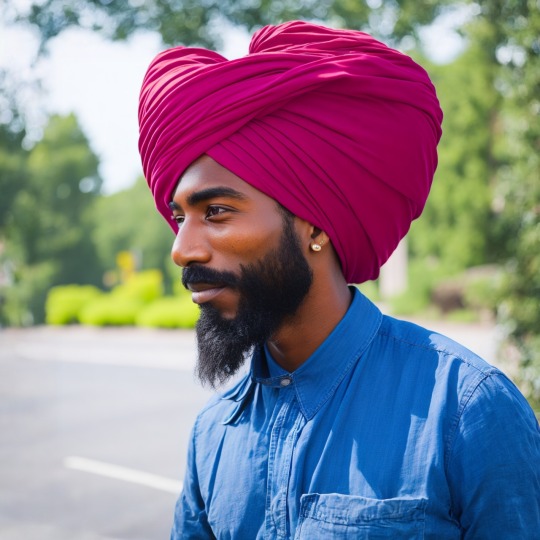
Phetas: Special turbans worn for religious purposes.
There are numerous types of phetas which are being used in different places across India for different purposes.
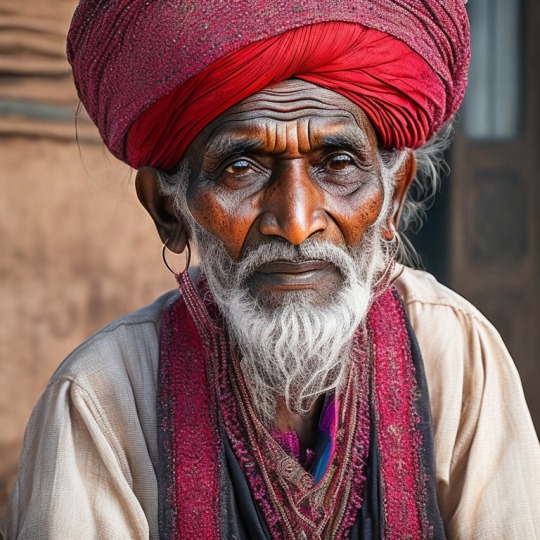
Peplon or chiton: Layered clothing made of linen and wool, adjusted according to weather conditions.

Man-buns and short or shaved beards were popular styles

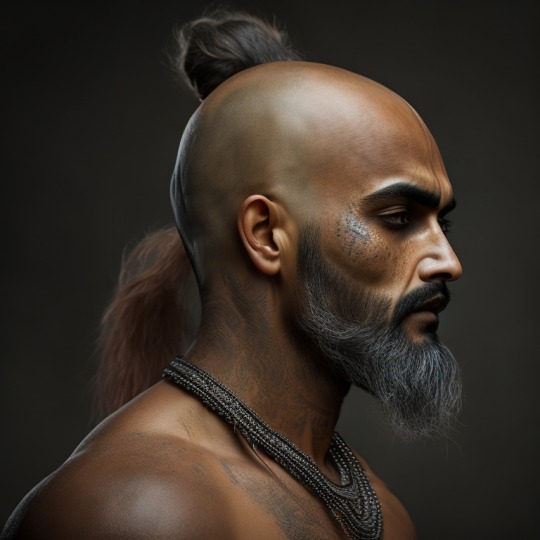
Clothing and Style for Women:
- Sari: A long piece of cloth draped around the body and over the head, showcasing elegance and grace
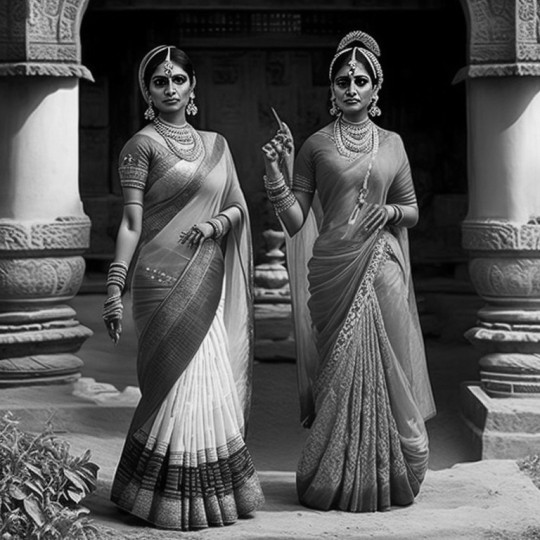
Knee-length skirts paired with intricate jewelry like bangles, earrings, and beaded necklaces.
- Elaborate jewelry made of stones, animal claws, feathers, and shells.
- Handloom textiles woven by skilled artisans.

- Gold ornaments, particularly worn by upper castes.
Sirradai: A short lower garment made of handspun cotton and silk.

Traditional Colors Used in Ancient Indian Clothing:
Ancient Indians were adept at dyeing clothes, and specific colors held symbolic significance:
- Ivory, jasmine, August moon, August clouds after the monsoon, and the color of the peacock's neck were significant traditional colors.
- The Vedic treatise Vishnudharmottara described these hues.
Traditional clothing of india
Men wore a variety of garments depending on their region, occupation, and social status. Some common examples include:
Lungi: A simple garment made of a single piece of cloth wrapped around the waist and legs, similar to a sarong.
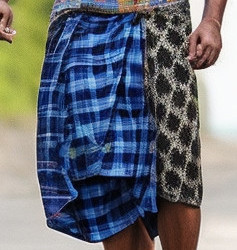
Veshti: A long piece of cloth wrapped around the waist and legs, similar to a dhoti but without the pleats.

Angrakha: A long tunic with a V-shaped neckline that is worn over a dhoti or other lower garment.
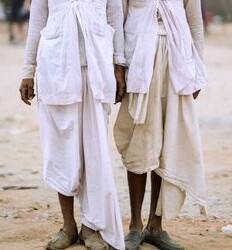
Sherwani: A long coat-like garment that was often worn for formal occasions.


Pajama: Loose-fitting pants that are typically worn with a kurta or other upper garment.
It's worth noting that the styles and materials of these garments varied widely depending on the time period and region in which they were worn.
Conclusion:
Ancient Indian clothing showcased the richness of culture, history, and artistry. Through the ages, men and women draped themselves in garments like dhotis, saris, turbans, and knee-length skirts, reflecting their customs, traditions, and social status. Warriors donned armor and wielded weapons as they protected their kingdoms. The vibrant colors derived from natural elements added splendor to the attire. The remnants of ancient Indian clothing, discovered through sculptures, paintings, and literature, provide us with a glimpse into the past, where clothing was not merely functional but also an expression of identity and heritage.
#beautyofindia #indianclothing #indianimpact #indianhertage#forgottenbharat
3 notes
·
View notes
Text
Online Indian Clothes & Wedding Outfits for Men at Paaro
Introduction
Indian weddings are known for their tradition, and complex outfits. Mens Indian wedding outfits online for cultural richness, vibrant colors, and complex embroidery, which is making them a vital part of the celebration. With the rise of e-commerce, finding the perfect Indian wedding dress online has never been easier. Whether you're looking for a traditional sherwani, a modern Indo-western suit, or a comfy kurta pajama, online stores offer a vast selection of styles, fabrics, and designs to suit every groom, newly-married man, and guest.
Popular Men's Indian Wedding Outfits
1. Sherwani – The Royal Costumes
The sherwani is the most liked outfit for grooms. This long, coat-like tunic is made with embroidery, beads, sequins, and threadwork, often paired with churidar pants or dhoti-style bottoms.
Search the style of Indian wedding dress styles with the sherwani, the most unique suit for grooms. Often paired with churidar pants or dhoti-style bottoms, the sherwani is a perfect combination of tradition and culture.
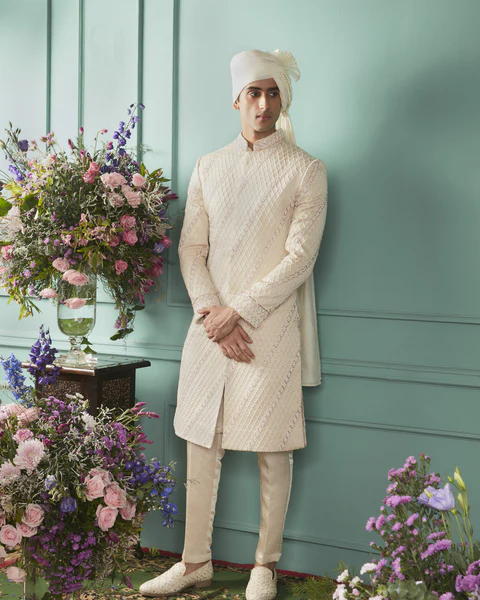
Types of Sherwanis:
Embroidered Sherwani
Velvet Sherwani
Indo-Western Sherwani
Jodhpuri Sherwani
Best Fabrics:
Silk
Velvet
Brocade
Jacquard
Where to Buy Online:
Many ecommerce platforms play a big role in Indian wedding dress collections, providing custom size and global shipping.
2. Kurta Pajama – A Versatile & Comfortable Option
For pre-wedding functions or guests, the kurta pajama is a perfect choice. It consists of a long tunic (kurta) paired with slim-fit trousers (pajama) or churidar.
Kurta pajamas are available in a wide range of fabrics, from breezy cotton and linen for daytime events to rich silk, brocade, and jacquard for evening functions .With the Indian wedding dress online, shopping for the perfect kurta pajama has become easiest .
Best Styles:
Silk Kurta Pajama
Embroidered Kurta Pajama
Pathani Kurta Pajama
Asymmetrical Kurta Pajama
3. Indo-Western Suit – The Fusion Look
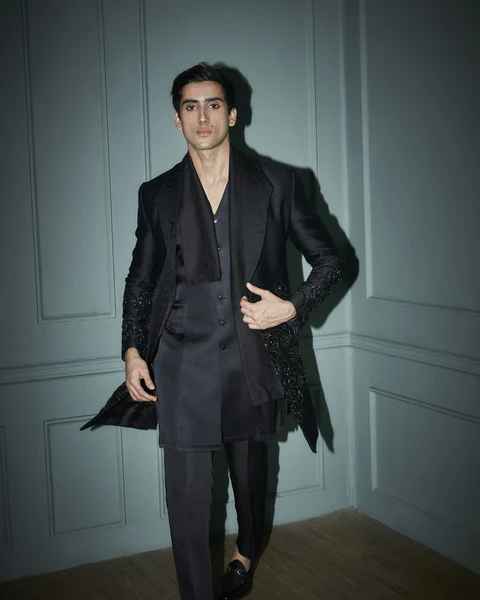
Indo-Western outfits mix traditional Indian parts with modern Western designs ,which makes them a modern choice for weddings.
With a vast selection of western style outfits available in Indian wedding dress collections online, searching the perfect combo has never been easier. Online platforms provide customization options, allowing individuals to select colors, fabrics, and embroidery styles that different with their personal style.
Key Features:
Asymmetric cuts
Minimal embroidery
Indo-western jacket paired with trousers
Best for:
Engagement parties
Reception
Cocktail events
4. Jodhpuri Suit – The Royal Rajputana Look
A Jodhpuri suit is an amalgamation of a western suit with Indian embroidery, ideal for formal wedding events.
The Jodhpuri suit, also known as the Bandhgala suit, is a perfect blend of Indian royalty and Western culture, which is a popular choice for weddings and formal occasions. This royal attire is characterized by its structured high-necked Nehru-style collar, and intricate embroidery or button detailing. The Jodhpuri suit is a go-to option for grooms, groomsmen, and wedding guests who want to exude elegance while embracing a culturally rich outfit.
Components:
Nehru-collar jacket
Tailored trousers
Embroidered buttons
5. Achkan – Classic & Elegant
Achkan is similar to a sherwani but simply in fabric and embroidery. It’s a great combination for summer weddings.
The Achkan is normally paired with churidar pants, slim-fit trousers, or dhoti-style bottoms, allowing for both traditional and contemporary styling. Accessories play a big role in enhancing its regal look. Grooms often complement their Achkan with a coordinating stole, a stylish turban, embroidered mojaris, and a statement brooch or pocket square.
Pair With:
Dhoti pants
Straight pants
Churidar
6. Select the Perfect Indian wedding Dress Online
With a variety of online stores, shopping for Indian wedding outfits has become easiest. Here’s how to make the best choice:
1. Understand Your Style & Occasion
Sherwanis for the groom
Kurta pajama for guests
Indo-western suits for reception or engagement
2. Choose the Right Fabric & Embroidery
Heavy embroidery for grand events
Light fabrics like cotton silk for summer weddings
3. Get the Right Fit
Many online stores provide custom tailoring services
Look for measurement guides before purchasing
4. Compare Prices & Check Reviews
Check customer reviews before ordering
Compare prices across different online platforms
5. Look for Discounts & Offers
Many Indian clothing websites offer festive discounts
Sign up for newsletters to get exclusive deals
Best Online Stores for Indian Wedding Outfits
Utsav Fashion – Wide range of traditional and Indo-western outfits
Manyavar – Premium collection for grooms and groomsmen
Pernia’s Pop-Up Shop – Designer men’s wear for weddings
Ajio & Flipkart – Budget-friendly options with trendy designs
Final Thoughts
Mens Indian dresses online for wedding outfits .It is a mix of tradition, elegance, and modernity. Whether you're the groom, a groomsman, or a wedding guest, finding the perfect Indian clothes online is now easier than ever. With countless options available, you can choose an outfit that suits your personality, event, and budget, making your presence stand out at any wedding celebration. So, start finding online stores and find the perfect ensemble for your big day!
#mensindianweddingoutfits#indianweddingdress#indianclothes#Indianoutfitsformen#Indianclothesonline#indiansuitsonline
0 notes
Text
[Image description taken from alt: Image 1: A shot of three men standing in an open metal doorway. In the center is a tall, handsome Indian man with a long beard and thick brows, looking down into the room with a neutral expression. He wears a turban and a robe with an ornate trim, slightly open beneath a sash tied at the front. The men on either side wear tunics of similar design with belts. To the left is a slightly less tall man with a scar running down his cheek into his beard. The man to the right is much shorter, peering through the gap between the door frame and the other’s shoulder. He has curly dark hair, long sideburns, and a curious expression. Image 2: Godfrey stands from the table, starting to lift one hand. He says, “Oh! Er, hello—my name is Godfrey Norton, and this is Dr. Seward and Jonathan Harker.” Beside him, Jonathan stands shakily, a bruise dark on one cheek and his hair straggling over his face. Jack holds him by the arm and clutches his other hand as if in surprise, wide-eyed and flustered. Image 3: Godfrey offers his hand for a handshake towards the man with the turban, who towers over him with arms folded behind his back. Godfrey says, “…I presume we have the pleasure of addressing our rescuers?” The man looks down at his hand but does not react. Image 4: The man turns to his two companions, and asks something in an elaborate unreadable text. The short man answers in the same language, leaning forward to look at the newcomers with a hint of a smile. The man with the scar replies as well, arms folded and posture guarded. Image 5: The man turns back to address the others with a warmer expression, saying in English, “Indeed you do. I am Captain Nemo. This is my first mate, Mr. Skutnik, and this—” The short man cuts in, “Call me Ishmael,” as he leans casually against the door frame and raises a hand in greeting. Between them, Skutnik remains silent with his arms crossed. End description.]





First page || Previous page || Next page
Start reading Episode 1
Dialogue transcripts:
Panel 1 (n/a)
Panel 2 Godfrey: Oh! Er, hello—my name is Godfrey Norton, and this is Dr. Seward and Jonathan Harker.
Panel 3 Godfrey: …I presume we have the pleasure of addressing our rescuers?
Panel 4 [Nemo, Ishmael, and Skutnik all speaking Nautilus language]
Panel 5 Nemo: Indeed you do. I am Captain Nemo. This is my first mate, Mr. Skutnik, and this— Ishmael: Call me Ishmael.
#captain nemo#ishmael#first mate skutnik#godfrey norton#jonathan harker#jack seward#described#league of extraordinary gentlefolk
379 notes
·
View notes
Text
Why Jodhpuri Suits Are a Must-Have for Every Man's Wardrobe
In the realm of traditional wear for men, few garments exude the level of sophistication and elegance that a Jodhpuri for men does. Known for its structured silhouette and regal appeal, the Jodhpuri suit has become a staple in Indian formal wear, especially for weddings and grand celebrations. This versatile outfit, also known as the Bandhgala suit, seamlessly blends traditional Indian elements with modern design, making it a must-have in every man's wardrobe. Let's explore the charm of the Jodhpuri suit and how it compares to other classic pieces like the sherwani for men, kurta set for men, Achkan, and single kurta. We'll also highlight how brands like Tasva are redefining traditional wear for the modern man.
Jodhpuri for Men: The Quintessential Indian Suit
The Jodhpuri suit is characterized by its high-collared jacket, which is often paired with matching trousers. The jacket, typically made from luxurious fabrics like silk, velvet, or brocade, is the centerpiece of the ensemble. It is usually embellished with subtle embroidery, buttons, or brocade work, giving it a refined and regal appearance.
What sets the Jodhpuri suit for men apart from other traditional garments is its structured fit, which enhances the wearer's silhouette and exudes confidence. The Jodhpuri suit is perfect for formal occasions like weddings, receptions, or high-profile events where you want to make a lasting impression. Its versatility allows it to be worn with or without a tie, depending on the formality of the occasion.
Brands like Tasva have taken the Jodhpuri suit to new heights by incorporating modern design elements while maintaining its traditional essence. Tasva's Jodhpuri suits feature contemporary cuts, innovative fabrics, and intricate detailing, making them a popular choice for men who appreciate the blend of tradition and modernity.
Sherwani for Men: The Epitome of Royalty
While the Jodhpuri for men is all about structure and elegance, the sherwani for men is synonymous with grandeur and opulence. Originating from the Mughal era, sherwanis have long been associated with royalty and are a popular choice for grooms on their wedding day.
Sherwanis are typically more ornate than Jodhpuri suits, featuring intricate embroidery, zari work, and luxurious fabrics. They are worn over a kurta or a shirt and paired with churidar pants or pajama trousers. The addition of a stole or dupatta and traditional footwear like mojdis completes the regal look.
For those looking for a truly grand and traditional outfit, the sherwani is an unbeatable choice. However, for events where a balance between tradition and modernity is desired, the Jodhpuri suit offers a more understated yet equally impressive alternative.
Kurta Set for Men: Versatile and Timeless
The kurta set for men is a classic and versatile option for those who want to embrace traditional wear without going overboard. A kurta set typically includes a long tunic-style top (kurta) paired with pajama pants or churidars. This ensemble is perfect for a wide range of occasions, from casual gatherings to festive celebrations.
Kurta sets come in various fabrics and designs, from simple cotton kurtas for everyday wear to silk or jacquard kurtas for more formal events. For men who prefer a more minimalist approach to traditional wear, a single kurta paired with jeans or trousers can offer a modern twist.
Brands like Tasva offer a wide range of kurta sets that combine traditional craftsmanship with contemporary styling, making them a popular choice for the modern man.
Achkan: A Fusion of Tradition and Modernity
The Achkan is another classic piece of traditional wear that shares similarities with the sherwani but with its own distinct features. The Achkan is typically a knee-length coat, often made from lighter fabrics like cotton or silk blends, making it more comfortable and suitable for various occasions.
While the sherwani is often reserved for the most formal events, the Achkan offers a more versatile option that can be dressed up or down depending on the occasion. It can be paired with churidars, pajamas, or even trousers for a more contemporary look, making it a perfect choice for semi-formal events.
The Jodhpuri for men is a timeless and sophisticated choice that perfectly blends tradition with modernity. Whether you are drawn to the grandeur of a sherwani, the versatility of a kurta set, or the understated elegance of an Achkan, there is a traditional outfit for every occasion. Brands like Tasva are leading the way in redefining traditional wear for the modern man, offering a wide range of options that cater to different tastes and preferences. Embrace the rich heritage of Indian fashion and elevate your style with the perfect traditional outfit.
Share this Blog & your thoughts with us in the comments below!
#jodhpuri suit for men#royal jodhpuri suit for wedding#velvet jodhpuri suit#jodhpuri suit for engagement#bandhgala suit for men
0 notes
Text
Embracing Contemporary Comfort : The Timeless Appeal of Men's Kurta Payjama in White
Introduction
In the vibrant tapestry of men's fashion, certain ensembles stand out not just for their aesthetic appeal but also for their cultural significance and comfort. One such attire that seamlessly blends tradition with modernity is the men's kurta payjama set in white. This classic ensemble exudes elegance, sophistication, and timeless charm, making it a popular choice for various occasions, from festive celebrations to formal gatherings. In this blog post, we'll delve into the allure of the white men's kurta payjama set, exploring its history, style, and contemporary relevance.

The Historical Roots
The kurta payjama has been a staple in South Asian men's attire for centuries, with its origins dating back to the Mughal era. Initially worn by royals and nobles, the kurta payjama evolved over time to become a symbol of cultural identity and sartorial elegance. Traditionally, it consists of a long tunic-style shirt (kurta) paired with loose-fitting trousers (payjama), reflecting the region's rich textile heritage and craftsmanship.
Timeless Sophistication
What sets the white men's kurta payjama apart is its timeless sophistication. The pristine white hue symbolizes purity, simplicity, and elegance, making it a versatile choice for various occasions. Whether it's a religious ceremony, wedding festivities, or a formal event, the white kurta payjama exudes understated luxury and effortless style. The simplicity of the ensemble allows for endless styling options, from traditional accessories like a dupatta (scarf) or a waistcoat to modern touches like tailored fits and contemporary silhouettes.
Modern Interpretations
While rooted in tradition, the white men's kurta payjama has undergone modern interpretations to suit the tastes and preferences of the contemporary man. Designers and fashion houses have reimagined this classic ensemble by experimenting with cuts, fabrics, and embellishments, adding a contemporary flair while preserving its cultural essence. From lightweight cotton and linen fabrics for casual wear to luxurious silk and brocade for formal occasions, there's a plethora of options available to suit every style and occasion.
Comfort and Versatility
One of the defining features of the men's kurta payjama set in white is its comfort and versatility. The loose-fitting silhouette of the kurta and payjama allows for ease of movement, making it ideal for long hours of wear. Whether you're attending a festive celebration or a formal event, you can rely on the comfort of this ensemble to keep you feeling relaxed and at ease. Moreover, its versatility makes it suitable for a wide range of settings, from casual outings to semi-formal gatherings, making it a wardrobe essential for every discerning gentleman.
Origins and Cultural Significance
The kurta payjama holds a special place in traditional South Asian attire, with its origins dating back centuries. Historically worn by men across the Indian subcontinent, the kurta—a loose-fitting tunic—paired with the payjama—loose-fitting trousers—was favored for its comfort and breathability in the region's warm climate. Over time, this attire became not only a symbol of cultural identity but also a sartorial statement of elegance and refinement.
Timeless Appeal in White
While the kurta payjama is available in a myriad of colors and designs, the classic white ensemble holds a unique allure. The pristine white fabric exudes an aura of purity and simplicity, making it a versatile choice for various occasions, from festive celebrations to casual gatherings and formal events. Whether adorned with intricate embroidery or kept minimalistic, the white men's kurta payjama exudes understated elegance and sophistication.
Contemporary Comfort and Style
In today's fast-paced world, comfort is paramount, and the men's kurta payjama set in white effortlessly blends comfort with style. Crafted from lightweight and breathable fabrics such as cotton, linen, or silk, this ensemble ensures ease of movement while keeping the wearer cool and comfortable even in warm climates. The loose silhouette of the kurta and payjama adds to the relaxed fit, allowing for unrestricted mobility and airflow—a perfect choice for modern men leading active lifestyles.
Styling Tips and Trends
When it comes to styling the men's kurta payjama set in white, the possibilities are endless. For a contemporary twist, consider opting for a mandarin collar or a button-down kurta with subtle detailing. Accessorize with statement jewelry, such as a classic watch or beaded bracelets, to add a touch of sophistication to your look.
Conclusion
In conclusion, the men's kurta payjama set in white epitomizes timeless elegance, cultural heritage, and contemporary comfort. Whether worn for traditional festivities or modern celebrations, this classic ensemble remains a perennial favorite among fashion enthusiasts worldwide. With its versatility, comfort, and understated charm, the white kurta payjama is more than just a garment; it's a sartorial statement that transcends time and trends. So, embrace the allure of this timeless ensemble and make a stylish impression wherever you go.
0 notes
Text
Contemporary Classics: Reinventing Kurta Pajama Style for Today's Man
Kurta Pajama, a traditional South Asian attire, has long been cherished for its elegance and comfort. Originating from the Indian subcontinent, this ensemble has transcended cultural boundaries to become a global fashion statement. In recent years, it has undergone a remarkable evolution, blending traditional craftsmanship with contemporary aesthetics to cater to the modern man's tastes.
The Evolution of Kurta Pajama
Traditional Roots
Historically, Kurta Pajama was worn as everyday attire in South Asian countries such as India, Pakistan, and Bangladesh. Its loose-fitting silhouette and breathable fabric made it ideal for hot and humid climates. The intricate embroidery and vibrant colors reflected the rich cultural heritage of the region.
Modern Adaptations
Today, Kurta Pajama has evolved beyond its traditional roots. Fashion designers have infused new life into this classic ensemble by experimenting with cuts, patterns, and embellishments. From sleek, minimalist designs to bold, contemporary interpretations, there's a Kurta Pajama style to suit every taste and occasion.

Why Kurta Pajama Style Matters Today
Versatility
One of the key reasons for Kurta Pajama's enduring popularity is its versatility. Whether you're attending a wedding, a religious ceremony, or a casual gathering, there's a Kurta Pajama ensemble that fits the bill. Its timeless appeal makes it a wardrobe staple for men of all ages.
Comfort
In today's fast-paced world, comfort is paramount. Kurta Pajama's relaxed fit and lightweight fabric ensure maximum comfort without compromising on style. Whether you're lounging at home or stepping out for a social event, you can always count on the comfort of your Kurta Pajama.
Cultural Significance
Beyond its aesthetic appeal, Kurta Pajama holds deep cultural significance for many communities. It symbolizes tradition, heritage, and identity, serving as a proud expression of one's cultural roots. By embracing Kurta Pajama style, men can connect with their cultural heritage while making a fashion statement.
Also visit:
Styling Tips for Kurta Pajama
Casual Looks
For a laid-back vibe, pair your Kurta Pajama with denim jeans or chinos. Opt for earthy tones and subtle prints for a relaxed yet stylish look. Complete the ensemble with a pair of sandals or loafers for the perfect blend of comfort and style.
Formal Attire
When dressing up for special occasions, choose a Kurta Pajama ensemble in luxe fabrics like silk or brocade. Add a Nehru jacket or a tailored blazer for a touch of sophistication. Finish off your look with classic leather shoes and minimal accessories for a polished appearance.
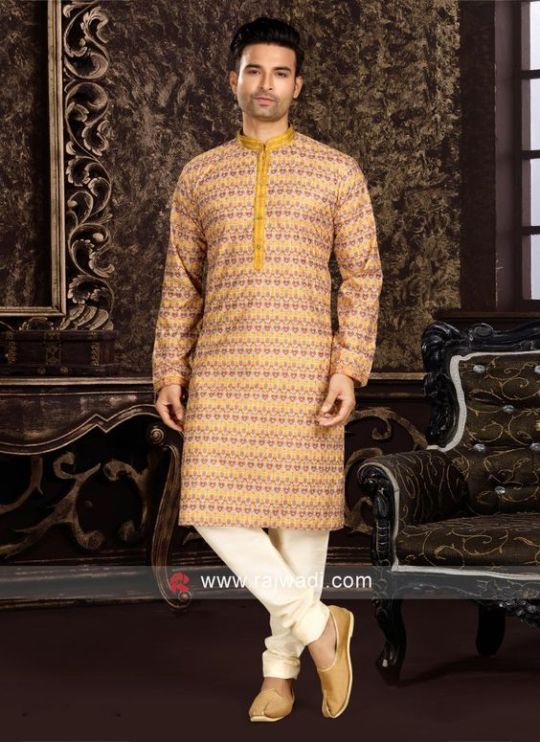
Kurta Pajama in Contemporary Fashion
Celebrities Sporting the Style
From Bollywood actors to Hollywood celebrities, Kurta Pajama has found favor with style icons around the world. Celebrities like Shah Rukh Khan, Ranveer Singh, and Jay Z have been spotted rocking Kurta Pajama ensembles on various occasions, further cementing its status as a fashion must-have.
Runway Trends
On the fashion runways, designers have been experimenting with new ways to reinvent Kurta Pajama style. From asymmetrical hemlines to avant-garde embellishments, there's no shortage of creativity in the world of Kurta Pajama fashion. With each season, designers push the boundaries of traditional craftsmanship to create bold, statement-making pieces.
Also visit:
Choosing the Right Kurta Pajama for You
Fabric Options
When shopping for Kurta Pajama, consider the occasion and the climate. Cotton is ideal for casual wear and warm weather, while silk and brocade are perfect for formal events and cooler temperatures. Pay attention to the fabric quality and craftsmanship to ensure longevity and comfort.
Fit Considerations
Finding the right fit is essential for a flattering Kurta Pajama ensemble. Opt for a silhouette that complements your body type, whether it's a slim-fit kurta or a relaxed-fit pajama. Pay attention to measurements and alterations if needed to achieve the perfect fit.
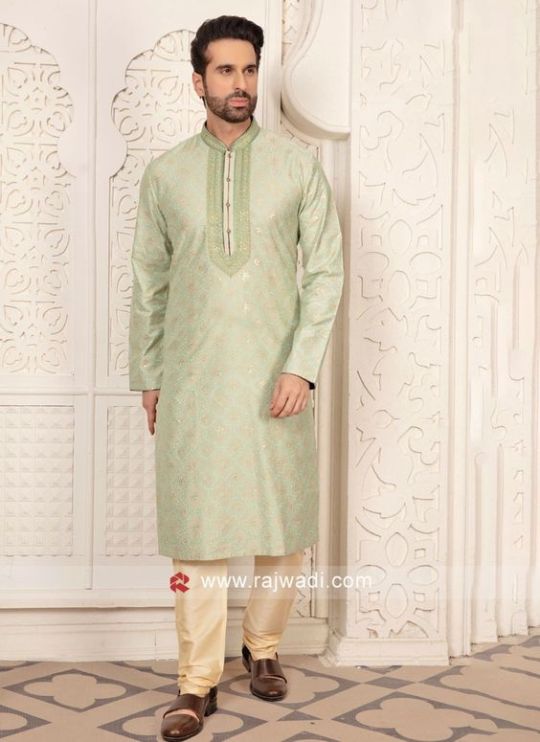
Conclusion
At Rajwadi, The enduring popularity of Kurta Pajama is undeniable, as it continues to enchant fashion-forward individuals worldwide. This iconic garment seamlessly blends timeless elegance with cultural roots. From traditional celebrations to modern sensibilities, there is a Kurta Pajama combination to suit any event. Its versatility, comfort, and historical significance make it a cherished wardrobe staple for men of all generations.
FAQs
Can I wear Kurta Pajama for everyday occasions? Absolutely! Kurta Pajama is perfect for everyday wear, offering comfort and style in equal measure.
How do I style Kurta Pajama for a formal event? For formal occasions, opt for a Kurta Pajama ensemble in luxe fabrics like silk or brocade, and accessorize with classic leather shoes and minimal jewelry.
Is Kurta Pajama suitable for all body types? Yes, Kurta Pajama comes in a variety of fits and silhouettes to suit every body type, so you're sure to find one that flatters your figure.
Can I customize my Kurta Pajama ensemble at Rajwadi? Absolutely! At Rajwadi, we offer customization services to ensure your Kurta Pajama ensemble fits you perfectly and reflects your personal style.
How can I care for my Kurta Pajama to maintain its quality? To keep your Kurta Pajama looking its best, follow the care instructions on the label and avoid harsh chemicals or machine washing. Instead, opt for gentle hand washing and air drying to preserve the fabric and embroidery.
0 notes
Text
When you dress up in a purely original costume, despite it not being Halloween (that day did not pan out all that well), and you ask your friends (now roommates) if you could borrow them for 1 minute to take a picture because your costume requires the use of both hands, and you don't want to spook the resident dog (named Bandit, while you're ironically serving up Bandit harder than he). But, they keep insisting you take the mask off to not spook the dog which was defeating the purpose of said request and dismissing the reasoning behind borrowing them (meaning stepping into another room)...all because they're too brain rotted from watching The Boys and Invincible, I swear. That's what they're doing right now. They just started Invincible. More media about assholes in costumes doing catastrophic things 'cause drama, and they couldn't be bothered to pay attention to their friend in a costume doing no harm for a minute. Couldn't be bothered to pause it. Couldn't be bothered to turn it down. Couldn't be bothered to listen 'cause I swear it's *like* they didn't hear me (even though they did), and I just said "ah, fuck it, never mind" and hobbled back upstairs to my room. Positive I heard one ask "what was that about?" as I ascended away from the dumbfuckery, like some silly fucking one-liner sitcom, lmao. Hate to sound pretentious. But, damn, I get let down on even the smallest things, and yet those things, be they small, actually mean something to me.
Mutuals, I am a hedge wizard of the far future, beyond the apocalypse, who, other than knowing skills related to healing and poultices, has also acquired the power of gun. My outfit is slightly androgynous. But, that's because gender conformity/non-conformity should be fucking irrelevant at that point, and you just wear what you find and what works. Wizards be pretty flashy with the fashy(ion) anyway.
Rough description:
- Neutral patchwork Indian poncho/scarf garb (I genuinely forget what it was called, only heard it once when I met a man from India who informed me of my apparel's origins, but, it's kept me warm, as was it's purpose for the immigrant students coming to Canada and I am forever grateful for the information) adorned with pins from travels (my travels have been limited but they mean a lot to me)
- said "poncho" layered over top of baggish longsleeved branch laden garb speckled with rhine stones that draped down to my knees and poofy collar with eccentric pointless zipper stitched in (copper pellet USP in one of two side pockets) popping out from underneath "poncho"
- black vertical contour Zara catsuit from neck to wrist to ankle featuring silver ring zipper from sternum to neck as base layer beneath baggish garb
- on head was black elastic headband pushing back my beyond shoulder length brown hair coming out beneath a bronze cat eared mask from mid-cranium/frontal cortex to cheekbones/upper nose bridge wrapped in barbed wire
- lime green paisley bandana as nose and mouth covering, obscuring neck where catsuit zipper would otherwise be visible
- black fingerless mitts pulled over ends of patterned sleeves from baggish branch laden garb
- brown leather braided belt fastened around waist pulling "poncho" together around baggish garb to better frame the torso like a tabbard over a tunic/gambeson
- red and blue velvet pouches one containing aventurine (a gift from my best friend) the other a Blarney stone (a gift brought back from Ireland from my best friend's sister who is also my friend) both bringing good luck and fortune for an adventurous spirit fixed to belt off to my left side
- slightly used tomahawk (not bloodied, it's okay, no violence) tucked behind same belt off to my right side
- brown leather Fergie knee high boots (zippers on each side of each boot, single strap and buckle on each down near the ankle) upper cuff flaring upwards at front and dipped down at back (originally used for Overwatch Mercy costume, too many men told me I was a trap and reluctantly attempted to flirt with me, it was hysterical, I am straight, I just like to wear cool stuff, doesn't help that I have a good frame either, toot toot my horn I will)
- did I mention the not-a-real-but-real-looking-gun (but real for the sake of the setting this could derive from) that would be a fun surprise for would-be underestimaters seeking to take advantage of what might be an unassuming healer of sorts?
- and to tie the wizard aesthetic together I have a shoulder high staff that's been in my family for a while now shaped like a monkey foot (not literally, but, we call it that, good for stamping unwanted bugs) that I would hold in my left hand while g.u.n. (gross underestimer neutralizer, still working on the name) or u.s.p. (unseen sneaky pistol, lines up with acronym, try harder guy) would be in my right hand (staff planted in ground, staff arm supporting gun hand for maybe seemingly weary but dangerous gunslinger, it's for character, yo)
I wanted to explain it all to them. Not literally all of the aforementioned details though because they'd just get to see it and there would be a degree of it speaking for itself, also they can barely pay attention longer than a minute. I wanted to show them all the bits of my costume, the same way they did with their costumes around Halloween. I was so enthused and ecstatic to see and hear about them. One was Gandalf, the other Gollum, both terrific DIY. I assisted with Gandalf through providing monkey foot staff, literal Glamdring replica I bought a while back when Green Earth closed at the mall, and a green glass wizard pipe I got from a friend at a secret Santa (fuck, that could also be part of my hedge wizard costume, kept in my other pocket). I wanted to share my late/latest costume with them, and tell them about the sentimental parts of my costume that played roles in holding it all together, shit that's slightly personal to me, lol. I wanted to have just one picture, like how they got pictures in their costumes from a bunch of people they saw at a party consisting of my friends of which I wasn't invited to. The absolute tone deafness of it all.
This shit feels a bit like a lackluster Tim Robinson skit right here, especially with the way I'm responding to this. I've been having a pretty hard time of late, and everywhere I go the people who matter to me just hurt through and through (dramatic, but, my life really is one jab to the heart after the next and the next and the next, not much respite between them most the time, at least not enough for me to not only heal but also get somewhere in life). I came home to heal from recent events, and they really couldn't indulge me for a moment. Still luv 'em tho.
Shit. I created art. Just wanted it to get out there somehow. Most fun I had creating something in a while, and I mean..I normally just have fun playing video games or whatever. Creating ideas and concepts and then flexecuting them feels way better. I didn't mean to type "flexecuting," but, I'm keeping that there. It means showing off your well thought out aesthetic. Flexecution, if you will. Anyone who says this better give credit or else eat copper..'cause I'll get you with my uspinger, ya dinger.
Why do I have friends and feel like the pure raw stuff I attempt to dish out to them is for whatever reason rank to everyone? It's hard to notice people caring if and when they do. Do people care about me, or do they just say they do? What do people like about me other than that I am nice and helpful and make them feel good? This line of questioning angers me.
Again, I've been having a hard time of late. Sorry for the existential dread over not being acknowledged in a costume. It's like childhood when your parents basically tell you to fuck off after you sought acknowledgement for something you felt proud of like a picture you might hope would go on the fridge or something.
HoW tRaGiC
0 notes
Text

Man in ceremonial dress poses on painted horse. He is wearing a feathered headress, tunic or jacket trimmed with feathers, decorated leggings & beaded moccasins; he holds a spear, and is seated on a horse painted with spots, and wearing a beaded breast collar and saddle blankets also trimmed with feathers. Caption on mount: By Dr. Latham. Joseph, the famous Chief of the Nez Perces, one of the greatest Indians that ever lived. 1903. Before the Chief would pose for this picture and the next he exacted $10 from the artist.
#chief joseph#nez perce#Hin-mah-too-yah-lat-kekt#nimiipuu#headdress#tepee#Horse#indigenous#native american#indigenous americans#20th century#Colville#Nespelem#history#photographs#historical photos
0 notes
Text
4 printed ethnic ensembles every man should have in his wardrobe
Ethnic ensembles have always been integral to Indian culture, and printed ensembles are no exception. The intricate designs and bold patterns of printed ethnic wear have been a long-standing tradition in India, representing the country's rich cultural heritage.
Over time, men's ethnic wear has evolved and gained immense popularity, with designers experimenting with different styles and fabrics. Today, designer Nehru jackets and Sherwanis for grooms are making an encore, and with them, the trend of printed ethnic wear is here to stay.
It's not just about embracing the cultural heritage of our country, but ethnic wear also helps men stand out in a crowd. However, with many options available in the market, selecting the right ethnic ensemble can be challenging. We aim to make things easier for you by highlighting the top 4 printed ethnic ensembles every man should have in his wardrobe.
Nehru Jacket
The Nehru jacket is a timeless classic that never goes out of style. Named after the first Prime Minister of India, Jawaharlal Nehru, this jacket is a popular choice for men who want to add a touch of sophistication to their outfits. The Nehru jacket is a versatile piece paired with a kurta or a shirt and trousers. It's available in various fabrics, including silk, linen, and cotton. The printed Nehru jacket is a classy and stylish choice that instantly elevates your outfit. And these exquisite prints on the Nehru jackets by Anita Dongre are a sight to behold. These jackets are perfect for any occasion, from the intricate floral patterns to the more abstract designs.
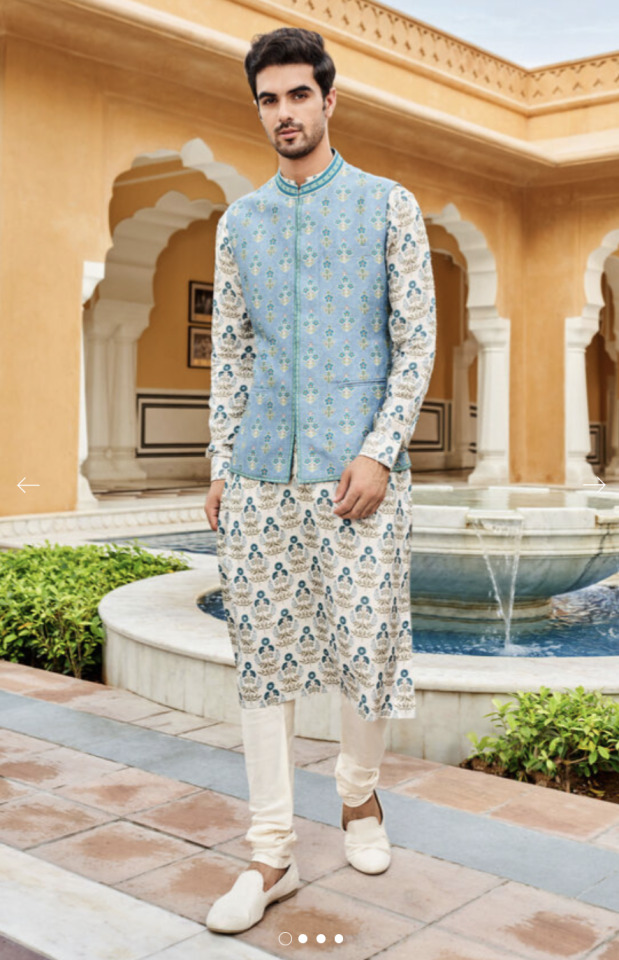
Link
Sherwani
Sherwani is a quintessential part of Indian weddings and every groom dreams of donning one on his special day. This long coat-like ensemble exudes elegance and royalty and is a popular choice for weddings and other formal events. A printed sherwani statement piece can take your outfit to the next level. It's available in various designs and patterns, from floral to geometric, and it's a must-have in every man's wardrobe. The intricate embroidery and prints on this Trish Sherwani for the groom by Anita Dongre are a testament to the exquisite craftsmanship of our country.

Link
Kurta
A Kurta is a traditional Indian garment that has been a staple in men's ethnic wear for centuries. This loose-fitting tunic is comfortable and versatile, making it a popular choice for casual and formal occasions. The printed Kurta is an exquisite choice that can add a touch of class to your outfit. It's available in various fabrics, including cotton, silk, and linen, and it's perfect for any season. This Kurta features a subtle print that adds depth and texture to the garment, while the blue colour is ideal for any day celebration.

Link
Bandhgala
A Bandhgala, also known as the Jodhpuri suit, is a fusion of Western and Indian styles. It's a sophisticated ensemble perfect for weddings and other formal events. It features a closed neckline and a buttoned-up front, giving it a regal appeal. A green-printed Bandhgala such as this one is a classy choice that can add a touch of elegance to your outfit.
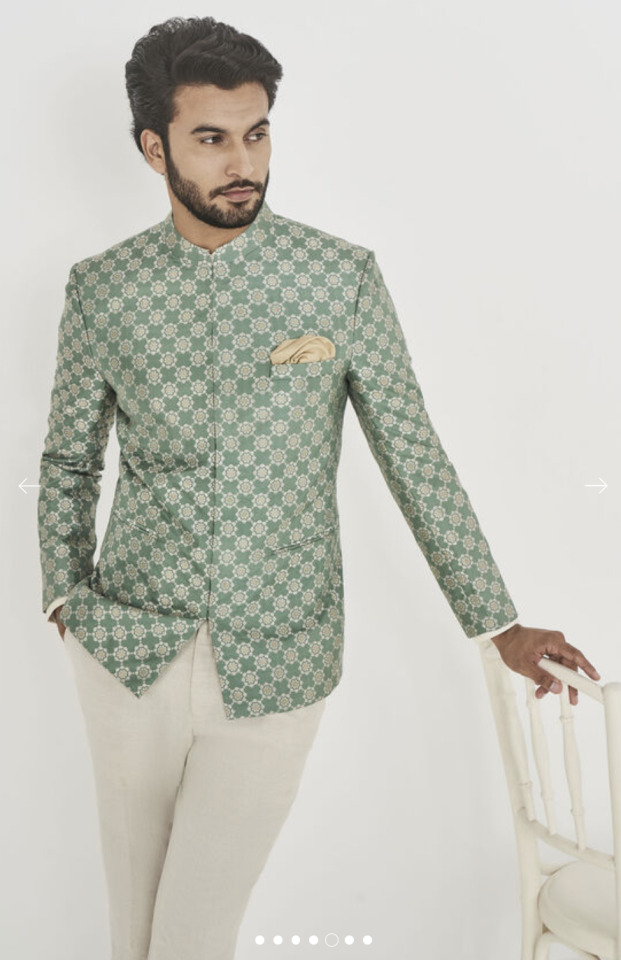
Link
Printed ethnic ensembles are an essential part of any man's wardrobe. These are a marvel of Indian craftsmanship and are perfect for any occasion. Embrace the rich cultural heritage of our country by adding these exquisite printed ethnic ensembles to your wardrobe today.
0 notes
Text
Empathy for the Devil Excerpt #2
Just one more week until Empathy goes live on Kindle Vella! I'd like to post on here more often, but I have no experience with this promo stuff. I don't want to annoy anyone by flogging my book all the time, but I don't really have much to say that isn't about the book.
Anyway, here is another snippet, this one from episode 2: Creatures in Cages. This is the moment when the MC, Ian, meets our other main character, Sarael. Warnings for language.
The figure strolled along the aisle, looking in each cage as they passed. It wasn’t until they glanced in at the bat-girl that I realized it was guy. His black hair fell in loose waves to his shoulders, shimmering with an iridescent sheen, like a rainbow or an oil-slick, and his dark skin was the most unusual shade of red-brown, almost East Indian or Native American, but not quite. He wore plain gray trousers and a blue tunic under a long, duster-length black coat that reminded me of a steampunk cosplayer I’d seen once.
As he turned away to look at the other side of the aisle, I caught a glimpse of his face, his jaw strong, his lips full, his cheekbones sharp and sculpted, and his eyes were the most unexpected shade of pale green. I felt my breath catch and my cock harden. I wasn’t gay, but fuck, he was the most beautiful man I’d ever seen.
He stopped and looked sharply at me, his soft, moss green gaze sliding down my body, causing a visceral reaction as effective as any physical touch. His lips quirked, like he knew, and my face grew hot.
“What are you smirking at?” I said, giving him the finger. That dampened his smile a little, but not enough. He spoke to me, his voice mellow and lyrical, even though I couldn’t understand a damn word he said. I was pretty sure everyone had this dream at some point, where everyone in the dream is speaking a foreign language, but I was ready to wake up.
He said something else and made a motion with his hand, tracing a circle in the air with one finger. It took a moment to realize he was telling me turn around so he could look at me. When I didn’t move, he spoke again, saying something different, I think, and pointed at my shirt. He motioned for me to take it off.
“Oh, hell no,” I said, taking a shaky step back from the wire. “Go fuck yourself, you pervert.”
0 notes
Text
as a desi specifically indian american scooby doo fan, i love this design!!! this is so cute!! for the scarf, the proper name would be a dupatta!
as for what religion she would practice, it depends! there's alot of religions practiced in india including hinduism, islam, christianity, jainism, sikhism and others! so depending on what you prefer, you can choose from any of these! i've noticed you made her vegetarian, so you could make her hindu as some hindus are vegetarians! i personally am not hindu, so I can't speak further on it, so others can feel free to elaborate more on it!
for dressing, i know it varies depending person to person! there are people whom i know who wear kurtas (a type of tunic common in south asia!) over jeans as a casual outfit or in everyday wear!
there are others i know who tend to wear more western clothes and try to incorporate pieces of their culture through jewelry or accessories like jhumka earrings or nose piercings!

these are jhumka earrings!
additionally, for jewelry, heavy jewelry is generally mostly worn for weddings, rather than on a everyday basis, so i don't know if velma would be wearing more fancy jewelry regularly? but i could see her with a nose piercing or occasional earring here and there!
i'd also recommend for research into how desi lesbians would act is watching movies featuring desi lesbians!! some of my recommendations include Badhaai Do (a movie about a gay man and a lesbian who enter into a lavender marriage to hide their sexualities from their parents! it has a happy ending and is cute!! will also make you cry!), Ek Ladki Ko Dekha Toh Aisa Laga (a movie about a woman who's under pressure to marry a man but realizes she's a lesbian and falls for a woman! this movie is a bit more sad and will make you cry, but has a happy ending and is very good!!)
Additionally, there's a popular couple online who are desi as well who are engaged sapphics! Their names are Anjali Chakra and Sufi Malik and they recently got engaged and I believe Anjali is Hindu while Sufi is Muslim! They have a youtube channel and are very adorable together!
This is all the information I can think of atm, feel free to ask anything more if you like!
Velma by Me!
A question for the Desi Scooby Fans
Hi guys! In my quest to rewrite the horror show that was HBO Velma, I decide to also redesign the characters, making some changes, mostly to their wardrobe, sometimes to their appearance. I will be keeping the changes in ethnicities while adding accordingly to the demands (my demands. I’m the one demanding) like making Shaggy Afro-Brazilian.
Now this brings me to my current query:
Is this design correct for Velma

I wanted to bring more influence from India into her design, but I’m also not Desi myself (I’m Brazilian) and India is a very big place with vastly different habits and traditions depending on where you are. Being half American would also add in ways I can’t even fathom.
If you guys could send me information (or direct me to somewhere where I can learn more) about how a Desi-American Lesbian girl would act, dress in her day to day, also reliable information about what religion she would practice and how it all would shape how she sees, interprets and interacts with the world I would be eternally grateful
Yours Truly,
The Scooby Gang (Gih. That’s me)
#scooby doo#desi tag#sorry for this being so long i got so excited by the prospect of desi lesbian velma FJDHSFAKJH
153 notes
·
View notes
Photo


Pure Cotton Indian Handmade Designer Trail Cut Men's Wear Fully Stitched Botton Down Kurta For Man.
0 notes